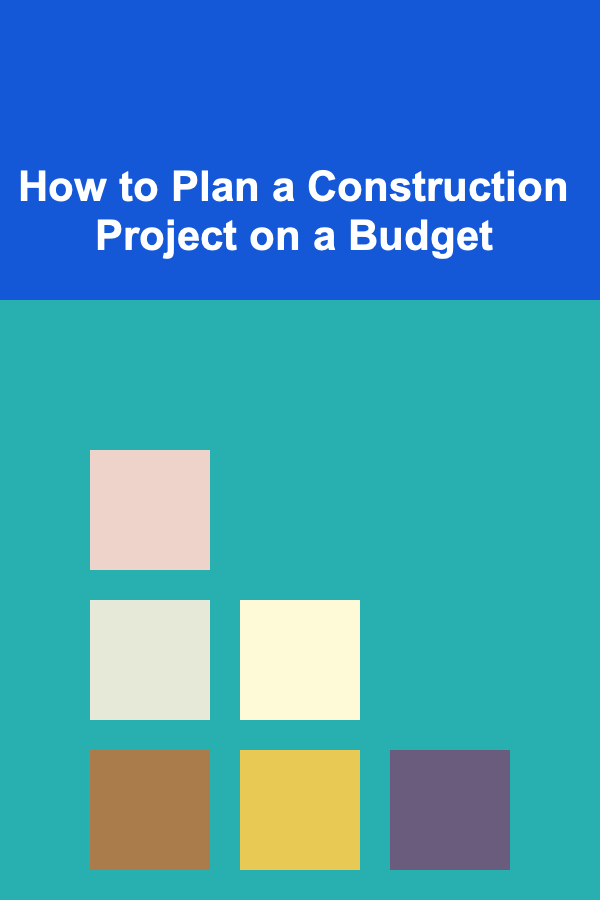
How to Plan a Construction Project on a Budget
ebook include PDF & Audio bundle (Micro Guide)
$12.99$6.99
Limited Time Offer! Order within the next:

Planning a construction project on a budget is a complex and multifaceted endeavor that requires careful foresight, strategic decision-making, and diligent management. Whether you are building a new home, renovating an existing structure, or overseeing a commercial development, the challenge remains: how to deliver a quality project while controlling costs. This article delves deeply into the essential components of budget-conscious construction project planning, exploring techniques, considerations, and practical strategies to help you achieve your goals without financial overreach.
Understanding the Importance of Budget Planning in Construction
Before diving into the specifics of budget planning, it's vital to understand why budgeting is crucial in construction projects:
- Avoiding Cost Overruns: Construction projects are notorious for exceeding initial cost estimates due to unforeseen issues, scope changes, and inflation. A solid budget plan anticipates these challenges and allocates funds accordingly.
- Ensuring Project Feasibility: Budget planning helps determine if the project is financially viable and aligns with stakeholders' expectations.
- Resource Allocation: It aids in optimal distribution of resources---labor, materials, equipment---maximizing value.
- Risk Management: Early identification of budget constraints helps mitigate financial risks and prepare contingency plans.
- Transparency and Accountability: A clear budget creates accountability among contractors, subcontractors, and clients.
Step 1: Defining Project Scope and Objectives Clearly
An accurately defined project scope is the cornerstone of budget planning. Ambiguities or frequent scope changes can derail budgets quickly.
Key Considerations:
- Detailed Requirements: List every element of the construction---size, materials, design specifications, timelines, and quality standards.
- Stakeholder Alignment: Ensure all parties (owners, architects, contractors) agree on the scope to minimize later disputes.
- Avoid Scope Creep: Be vigilant about preventing unauthorized additions or changes that inflate costs.
Tools to Aid Scope Definition:
- Work Breakdown Structure (WBS): Break the project into manageable components with clear deliverables.
- Scope Statement Document: A formal document outlining inclusions, exclusions, and assumptions.
Step 2: Conducting a Comprehensive Site Analysis
Understanding the physical site conditions is critical to accurate budgeting. Site-related challenges often account for unexpected expenses.
What to Analyze:
- Topography and Soil Conditions: Poor soil quality may require additional foundation work.
- Access and Logistics: Difficult access increases transportation and equipment costs.
- Environmental Constraints: Protected habitats, water tables, or contamination require mitigation.
- Existing Structures or Utilities: Demolition, relocation, or integration efforts add to costs.
How to Manage Costs Here:
- Early Geotechnical Surveys: Conduct surveys before design finalization.
- Engage Local Experts: Use local contractors familiar with site challenges.
- Plan for Contingencies: Budget for unforeseen site conditions.
Step 3: Creating a Realistic Cost Estimate
Cost estimation is both art and science. The accuracy of your estimates directly influences budgeting effectiveness.
Types of Estimates:
- Preliminary Estimates: Rough order of magnitude estimates useful in early planning.
- Detailed Estimates: Based on quantity take-offs and unit pricing, more accurate and used during design finalization.
- Bid Estimates: Provided by contractors during tendering.
Key Components of Construction Cost:
- Direct Costs: Labor, materials, equipment.
- Indirect Costs: Project management, permits, insurance.
- Contingency Allowances: Reserved for unexpected expenses.
- Profit Margins: For contractors and suppliers.
Methods to Enhance Estimation Accuracy:
- Use Historical Data: Reference past projects of similar scope.
- Leverage Estimation Software: Tools like RSMeans or CostX improve precision.
- Engage Quantity Surveyors: Professionals skilled in detailed cost forecasting.
Step 4: Developing a Detailed Project Schedule
A well-planned schedule reduces downtime and cost escalation.
Scheduling Considerations:
- Sequence of Activities: Define the order and dependencies between tasks.
- Resource Availability: Align labor and equipment availability with tasks.
- Seasonal and Weather Impacts: Plan around weather conditions to avoid delays.
- Permits and Inspections: Account for regulatory timelines.
Scheduling Tools:
- Gantt Charts: Visual timeline of activities.
- Critical Path Method (CPM): Identifies the sequence of critical tasks.
- Project Management Software: Examples include MS Project, Primavera.
Step 5: Procurement Strategy for Cost Control
Material and service procurement significantly impacts the budget.
Procurement Approaches:
- Competitive Bidding: Soliciting multiple bids to ensure competitive pricing.
- Negotiated Contracts: Building relationships with reliable suppliers for better terms.
- Bulk Purchasing: Buying materials in bulk to reduce unit costs.
- Local Sourcing: Using locally available materials to save on transportation and tariffs.
Procurement Tips:
- Early Ordering: Order long-lead items early to avoid expedited shipping fees.
- Verify Quality: Cheaper materials may cause long-term issues; balance cost and quality.
- Flexible Contracts: Include clauses to manage price volatility in materials.
Step 6: Efficient Project Team Management
Labor costs often constitute a major part of construction budgets.
Strategies for Managing Labor Costs:
- Hire Experienced Personnel: Skilled workers reduce errors and rework.
- Optimize Crew Sizes: Avoid overstaffing to reduce wage expenses.
- Use Subcontractors Wisely: Outsource specialty tasks to experts.
- Implement Training Programs: Improves efficiency and safety.
Communication and Coordination:
- Maintain clear communication to prevent misunderstandings.
- Use daily or weekly progress meetings.
- Employ collaboration tools for task tracking.
Step 7: Monitoring and Controlling the Budget
Creating a budget is not enough; ongoing tracking is essential.
Cost Control Techniques:
- Regular Financial Reporting: Weekly or monthly cost reports.
- Variance Analysis: Compare actual costs vs. budget to identify deviations.
- Change Order Management: Evaluate the financial impact of changes before approval.
- Use Earned Value Management (EVM): Integrates scope, schedule, and cost to measure performance.
Step 8: Risk Management and Contingency Planning
Unexpected risks are inherent in construction and can derail budgets if not managed.
Common Risks:
- Design Changes
- Material Price Fluctuations
- Labor Shortages
- Weather Delays
- Regulatory Issues
Mitigation Strategies:
- Risk Identification Workshops: Engage team members to list potential risks.
- Contingency Budgeting: Set aside 5-10% of total budget for contingencies.
- Flexible Scheduling: Buffer critical tasks.
- Insurance Coverage: Protect against liabilities and damages.
Step 9: Leveraging Technology for Budget Efficiency
Modern technology can optimize budget management and reduce costs.
Useful Technologies:
- Building Information Modeling (BIM): Improves design accuracy and clash detection.
- Drones: For site surveys, reducing manual labor.
- Project Management Software: Enhances collaboration and transparency.
- Cost Estimation Software: Automates take-offs and pricing.
Step 10: Sustainable and Cost-Effective Construction Practices
Sustainability can reduce lifecycle costs and improve project value.
Practices to Consider:
- Use of Recycled Materials: Saves money and reduces environmental impact.
- Energy-Efficient Design: Lowers operating costs post-construction.
- Modular Construction: Prefabricated components speed up construction and reduce waste.
- Waste Management: Efficient waste disposal lowers cleanup expenses.
Case Study: Budget Planning in a Residential Renovation Project
To illustrate these principles, consider a mid-size residential renovation with a budget of $300,000.
Initial Steps:
- Defined clear scope: kitchen and bathroom remodel plus exterior repairs.
- Conducted detailed site survey to assess structural integrity.
Cost Estimation:
- Detailed cost estimates sourced using local contractor bids.
- Included 10% contingency to cover unforeseen issues such as plumbing repairs.
Scheduling:
- Developed a 4-month project timeline with clear milestones.
Procurement and Team:
- Negotiated bulk discounts on cabinetry and fixtures.
- Hired subcontractors with fixed-price contracts for specialty work.
Outcome:
- Final cost $290,000, completed on schedule.
- Savings achieved by early procurement and scope discipline.
Conclusion
Planning a construction project on a budget requires a comprehensive approach that blends detailed planning, constant monitoring, risk management, and strategic resource allocation. Success hinges on clear scope definition, accurate cost estimation, efficient scheduling, and smart procurement practices. Leveraging technology and sustainable building methods further optimize costs.
By following these guidelines and maintaining rigorous discipline throughout the project lifecycle, construction professionals can deliver high-quality projects that meet financial targets and client expectations. Budget constraints need not limit creativity or quality---they can, instead, foster innovative, efficient, and sustainable construction solutions.
If you have any particular aspects you'd like to explore further, such as specific budgeting techniques, procurement contracts, or technology tools, feel free to ask!
Reading More From Our Other Websites
- [Home Budget 101] How to Automate Your Home Budget for Less Stress and More Savings
- [Home Staging 101] How to Make Your Kitchen Look Bigger and More Inviting
- [Personal Finance Management 101] How to Create a Minimalist Budget for a Simpler Financial Life
- [Personal Care Tips 101] How to Make Your Skin Smooth with a Hydrating Toner
- [Home Budget Decorating 101] How to Update Your Home's Lighting Without Breaking the Bank
- [Home Budget Decorating 101] How to Make Personalized Easy Home Decor Crafts from Dollar Store Finds
- [Digital Decluttering Tip 101] Best Workflow Automation Hacks to Reduce Digital Clutter in SaaS Companies
- [Home Budget 101] How to Budget for Seasonal Home Needs and Expenses
- [Organization Tip 101] Best Organization Tools for DIY Projects
- [Home Maintenance 101] How to Install a Home Security Camera System Without Breaking the Bank

How to Block Out Noise in an Urban Apartment
Read More
How to Create a New Year's Eve Celebration at Home
Read More
How to Franchise a Profitable Business
Read More
How to Monetize Your Skills in the Digital Age
Read More
How to Set Up a Real Estate Investment Group
Read More
10 Tips for Creating a Themed Music Listening Planner
Read MoreOther Products

How to Block Out Noise in an Urban Apartment
Read More
How to Create a New Year's Eve Celebration at Home
Read More
How to Franchise a Profitable Business
Read More
How to Monetize Your Skills in the Digital Age
Read More
How to Set Up a Real Estate Investment Group
Read More